
Honeymoon – Moofushi, Atollo di Ari – Maldive
Aprile 1997
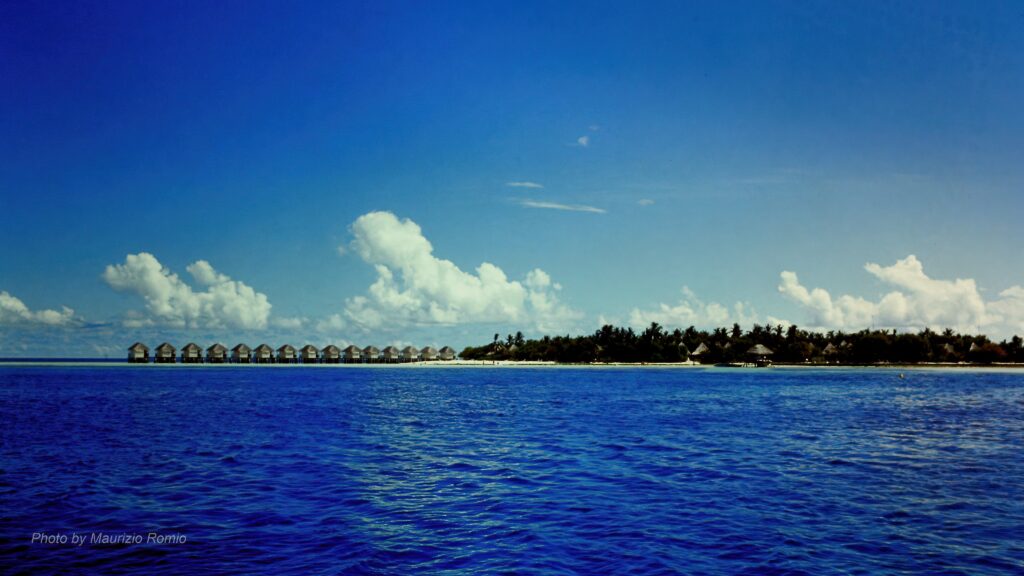


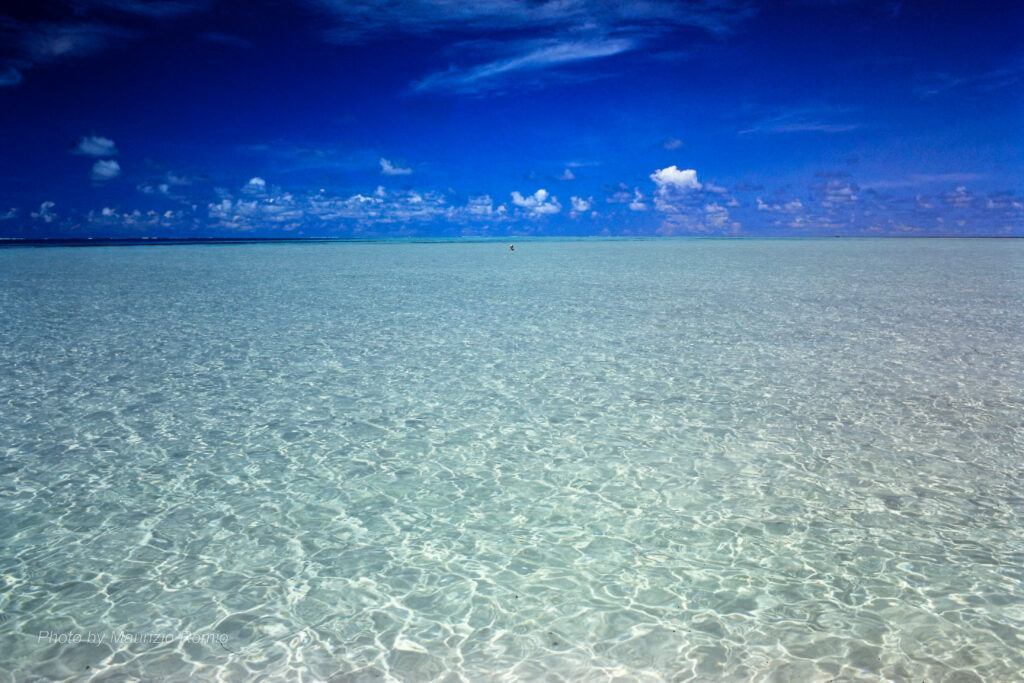
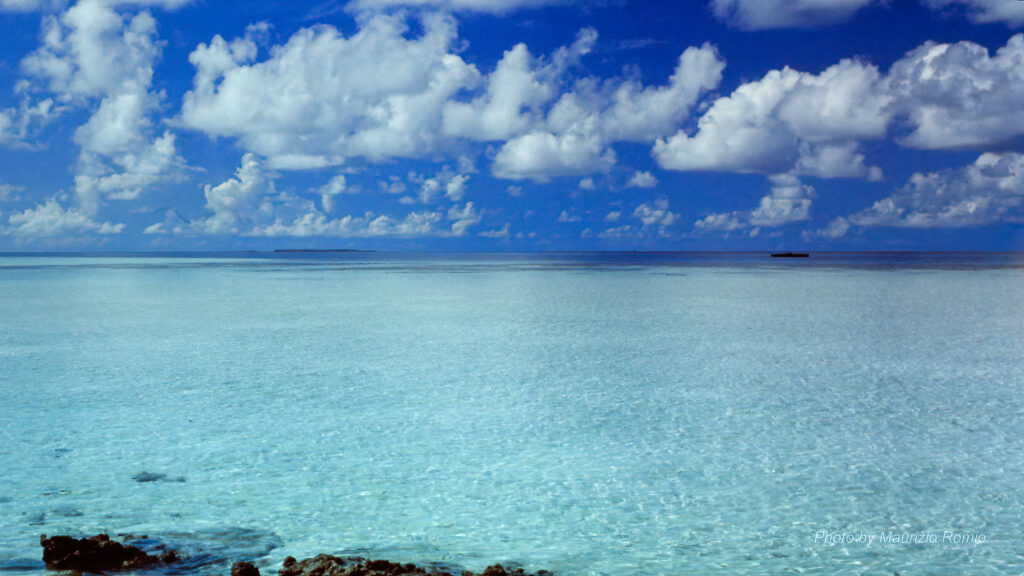
Honeymoon – Delta del Po
Mentre la femmina di Volpoca si nutre, il compagno maschio scruta l’ambiente circostante per sincerarsi che non ci siano minacce. L’amica Pettegola, loro accanto, in un aiuto vicendevole conferisce un ulteriore conforto ai pericoli.
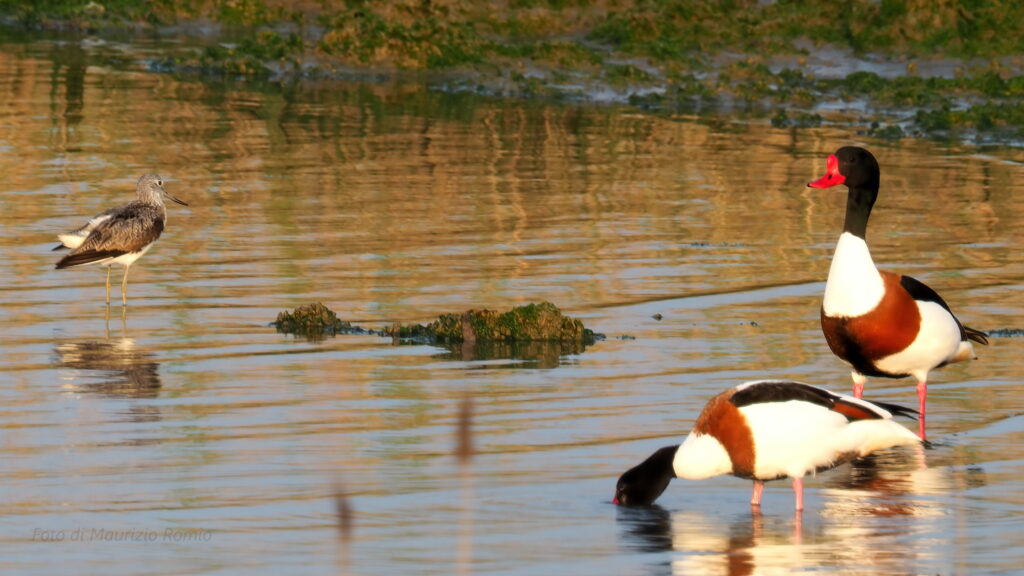
Foto Maurizio Romio. Data scatto: 11 aprile 2023. Località: Santa Giulia, Delta del Po,Italy. Fotocamera Olympus OM-D E-M10 III + M.Zuiko 100-400 f5.0-6.3 + M.Zuiko MC-20, ƒ/14, 1/160 sec., 800 mm, efov 1600 mm, ISO 500, treppiede, crop. (Click on the photo to enlarge)

Foto Maurizio Romio. Data scatto: 11 aprile 2023. Località: Santa Giulia, Delta del Po,Italy. Fotocamera Olympus OM-D E-M10 III + M.Zuiko 100-400 f5.0-6.3 + M.Zuiko MC-20, ƒ/14, 1/160 sec., 800 mm, efov 1600 mm, ISO 500, treppiede, crop. (Click on the photo to enlarge)

Foto Maurizio Romio. Data scatto: 11 aprile 2023. Località: Santa Giulia, Delta del Po,Italy. Fotocamera Olympus OM-D E-M10 III + M.Zuiko 100-400 f5.0-6.3 + M.Zuiko MC-20, ƒ/13, 1/160 sec., 800 mm, efov 1600 mm, ISO 400, treppiede, crop. (Click on the photo to enlarge)
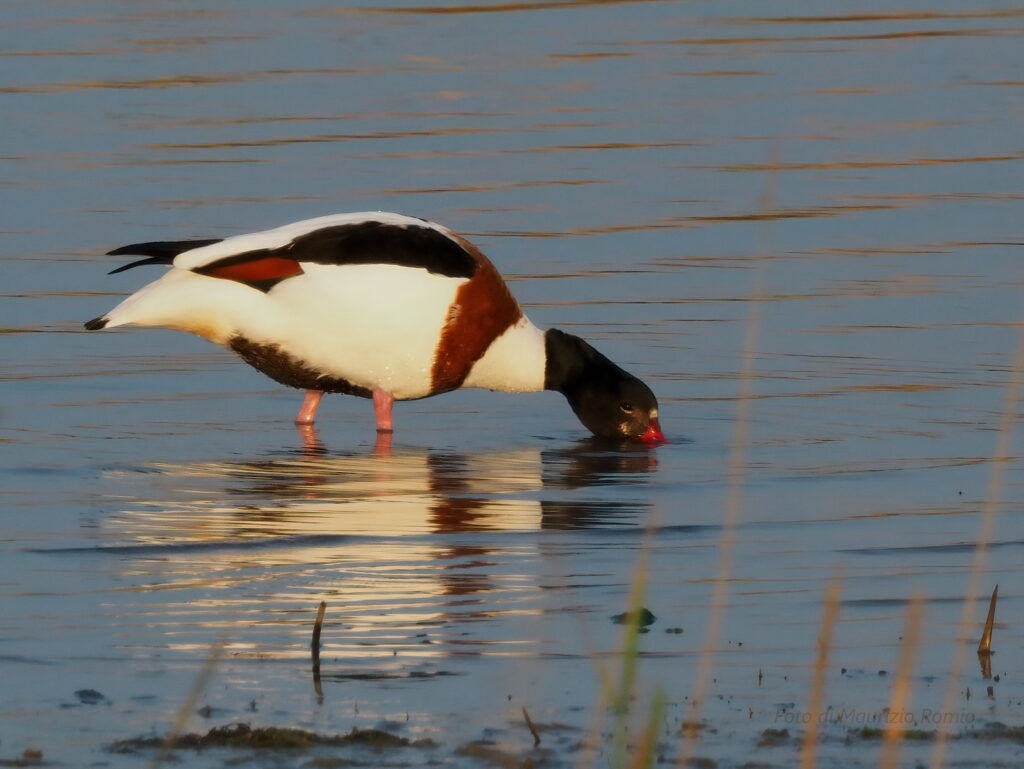
Foto Maurizio Romio. Data scatto: 11 aprile 2023. Località: Santa Giulia, Delta del Po,Italy. Fotocamera Olympus OM-D E-M10 III + M.Zuiko 100-400 f5.0-6.3 + M.Zuiko MC-20, ƒ/14, 1/640 sec., 800 mm, efov 1600 mm, ISO 1600, treppiede, crop. (Click on the photo to enlarge)

Foto Maurizio Romio. Data scatto: 11 aprile 2023. Località: Santa Giulia, Delta del Po,Italy. Fotocamera Olympus OM-D E-M10 III + M.Zuiko 100-400 f5.0-6.3 + M.Zuiko MC-20, ƒ/14, 1/640 sec., 800 mm, efov 1600 mm, ISO 1250, treppiede, crop. (Click on the photo to enlarge)
Volpoca (nome scientifico Tadorna tadorna)
Il nome comune di questo uccello, volpoca, composto dai nomi “volpe” e “oca”, volp – oca, deriva dal fatto che questo volatile spesso utilizza, come riparo per la riproduzione, i cunicoli scavati nel terreno dalle volpi o da altri animali. Si distingue facilmente il maschio di volpoca dalla femmina osservando il becco; il maschio ha il becco color rosso e presenta un piccolo rigonfiamento prominente su di esso mentre la femmina presenta un becco color rosa arancio senza la protuberanza caratteristica del becco del maschio.
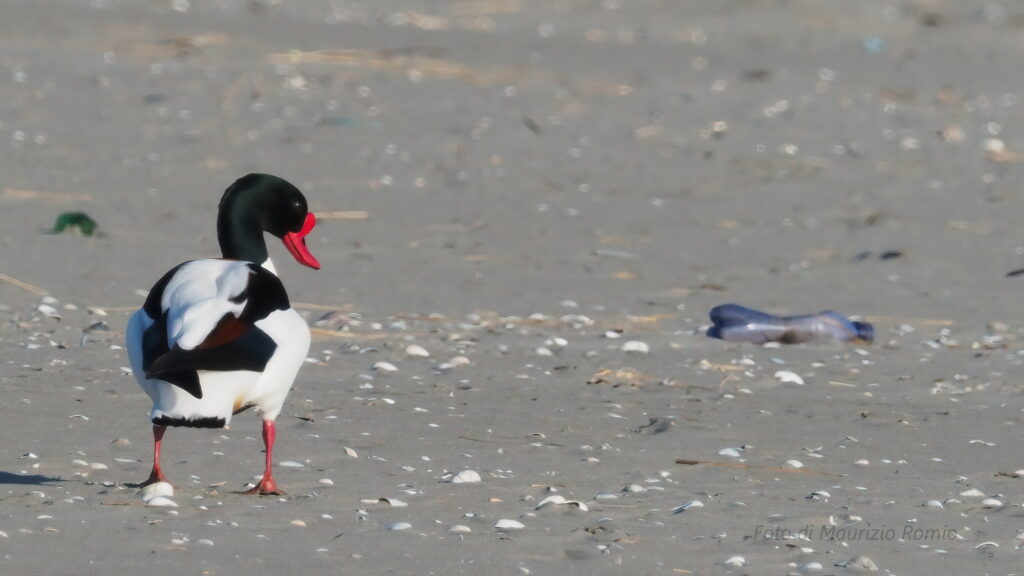
La volpoca preferisce zone salmastre, costiere e sabbiose. Si ciba principalmente di alghe, crostacei, piccoli pesci, insetti, vermi, lumache acquatiche che cerca immergendo il suo becco nell’acqua o nel terreno fangoso.


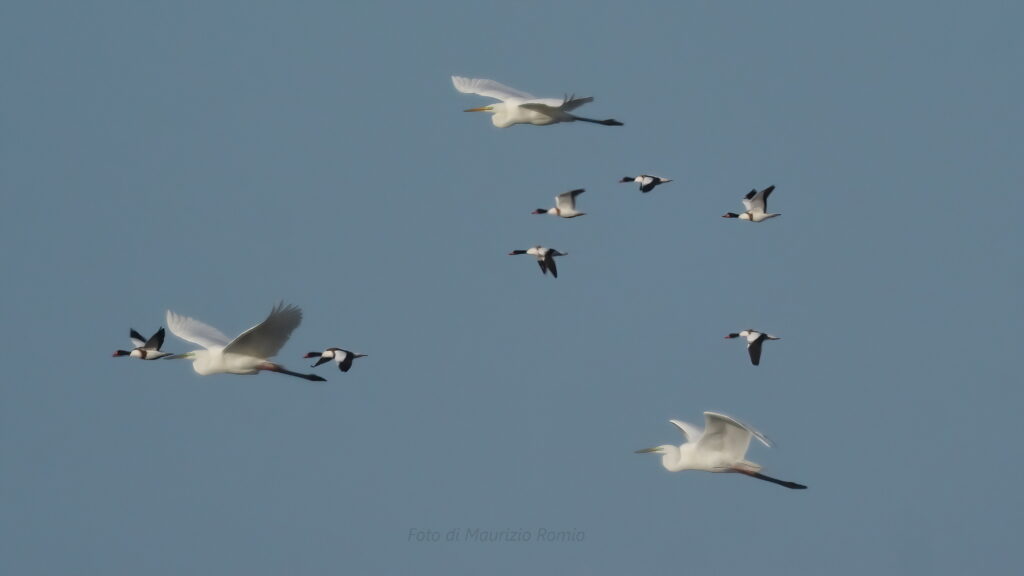
Note. Come per il mio precedente articolo del 15 marzo 2023 dal titolo “M Zuiko Digital lens ED 100 400 F5.0 6.3 IS with M Zuiko Digital 2x teleconverter MC-20” per i scatti fotografici ho usato il teleobiettivo Olympus M. Zuiko 100 400 f5.00-6.3 IS collegato al teleconverter M. Zuiko 2X MC-20 allo scopo di capire i vantaggi e i limiti di questo abbinamento.
Shelduck (scientific name Tadorna tadorna)
The common Italian name of this bird, “Volpoca” derives from the fact that it often uses burrows dug in the ground by foxes or other animals as breeding shelter. One can easily distinguish the male shelduck from the female by observing the beak; the male has a red-colored beak and has a small prominent bulge on it while the female has an orange-pink beak without the protuberance characteristic of the male’s beak. The shelduck prefers brackish, coastal and sandy areas. It feeds mainly on algae, crustaceans, small fish, insects, worms, and aquatic snails, which it searches for by dipping its beak into water or muddy soil.
Notes. As in my previous article dated March 15, 2023 titled “M Zuiko Digital lens ED 100 400 F5.0 6.3 IS with M Zuiko Digital 2x teleconverter MC-20” for the photographic shots, I used the Olympus M. Zuiko 100 400 f5.00-6.3 IS telephoto lens connected to the M. Zuiko 2X teleconverter MC-20 for the purpose of understanding the advantages and limitations of this combination.
M Zuiko Digital lens ED 100 400 F5.0 6.3 IS with M Zuiko Digital 2x teleconverter MC-20
Continua la mia esperienza nel campo della fotografia alla fauna selvatica. Al mio corredo fotografico Olympus, ora OM Digital Solution, ho recentemente aggiunto un duplicatore di focale 2x. Per capirne l’uso e la praticità ho deciso quindi di scattare alcune fotografie agli uccelli nel mio circondario utilizzando la mia macchina fotografica Olympus OM-D E M10 III in abbinamento con il teleobiettivo M. Zuiko Digital ED 100 400 f5.00-6.3 IS e il duplicatore di focale M.Zuiko Teleconverter MC-20. L’obiettivo M.Zuiko 100-400mm micro quattro terzi offre la lunghezza focale 200-800mm del formato full frame 35 mm. Applicando a quest’ ottica il duplicatore di focale Teleconverter MC-20 si raddoppia la lunghezza focale e alla massima estensione dell’obiettivo si arriva ai 1600mm del formato 35 mm. Ho cercato in questo contesto di tener presente e provare ad esprimere attraverso questi miei scatti il concetto antico dell’ aurea mediocritas che considera aureo la via di mezzo tra gli opposti o, per usare un altro termine, tra gli estremi.
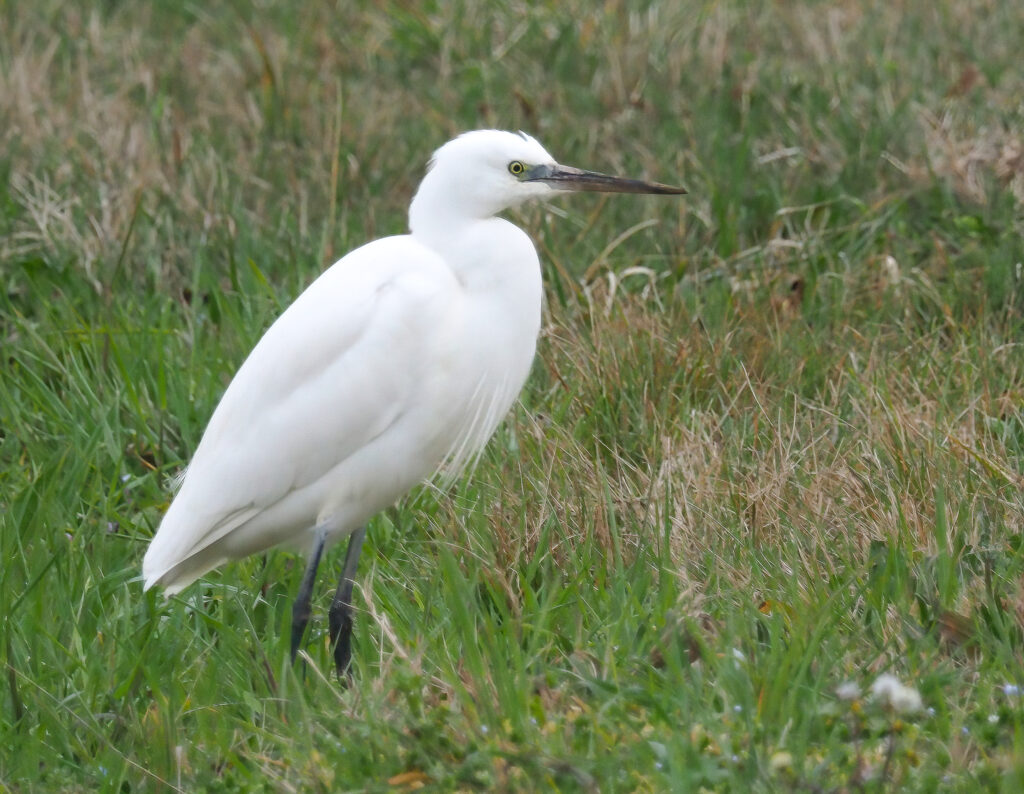

Vari sono gli elementi con i quali mediare, in primis la velocità di scatto e la sensibilità ISO. Naturalmente le dimensioni del soggetto fotografato e la sua distanza dal punto di ripresa condizionano il risultato che si può ottenere. Un uccellino di 14 cm ad una distanza di 40 metri fotografato con una focale m4/3 di 800mm occupa circa il 20% del sensore.

In post produzione si può eventualmente procedere all’ingrandimento dell’immagine originale ma in questo caso si perde in qualità. Di una foto è importante valutare anche il suo significato intrinseco. A volte un interesse documentaristico può prevalere rispetto alla resa fotografica.

La visione dei minimi dettagli del soggetto fotografato può essere secondaria rispetto ad altri aspetti.

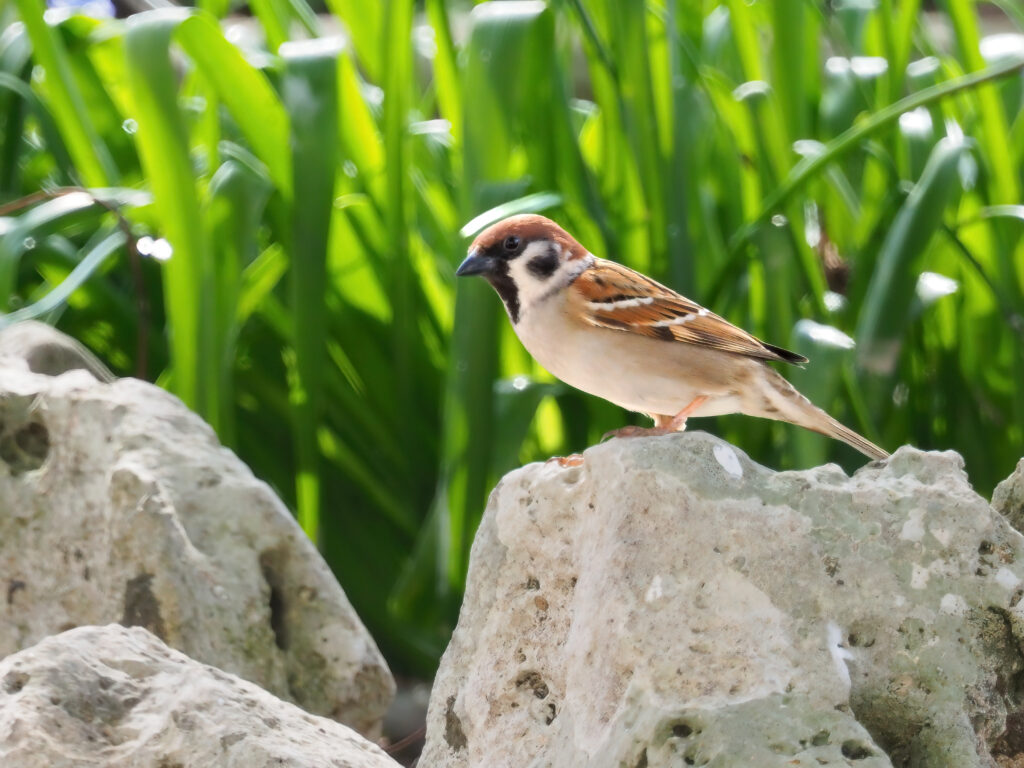

My experience in wildlife photography continues. To my Olympus photography kit, now OM Digital Solution, I recently added a 2x focal length duplicator. Therefore, to understand its use and practicality, I decided to take some photographs of birds in my surroundings using my Olympus OM-D E M10 III camera in combination with the M. Zuiko Digital ED 100 400 f5.00-6.3 IS telephoto lens and the M.Zuiko Teleconverter MC-20 focal length duplicator. The M.Zuiko 100-400mm micro four-thirds lens offers the 200-800mm focal length of the 35mm full frame format. Applying the Teleconverter MC-20 focal length duplicator to this ‘optic doubles the focal length and at the maximum extension of the lens reaches 1600mm of the 35 mm format. I have tried in this context to keep in mind and try to express through these shots of mine the ancient concept of ‘aurea mediocritas that considers golden the middle ground between opposites or, to use another term, between extremes. Various are the elements with which to mediate, primarily the shooting speed and ISO sensitivity. Of course, the size of the subject being photographed and its distance from the shooting point condition the result that can be achieved. A 14-cm bird at a distance of 40 meters photographed with an m4/3 focal length of 800mm takes up about 20 percent of the sensor. In post production one can possibly enlarge the original image but in this case quality is lost. Of a photo it is also important to evaluate its intrinsic meaning. Sometimes a documentary interest may outweigh photographic output. Seeing the smallest details of the photographed subject may be secondary to other aspects.
Avifauna in Costabissara
Gheppio comune
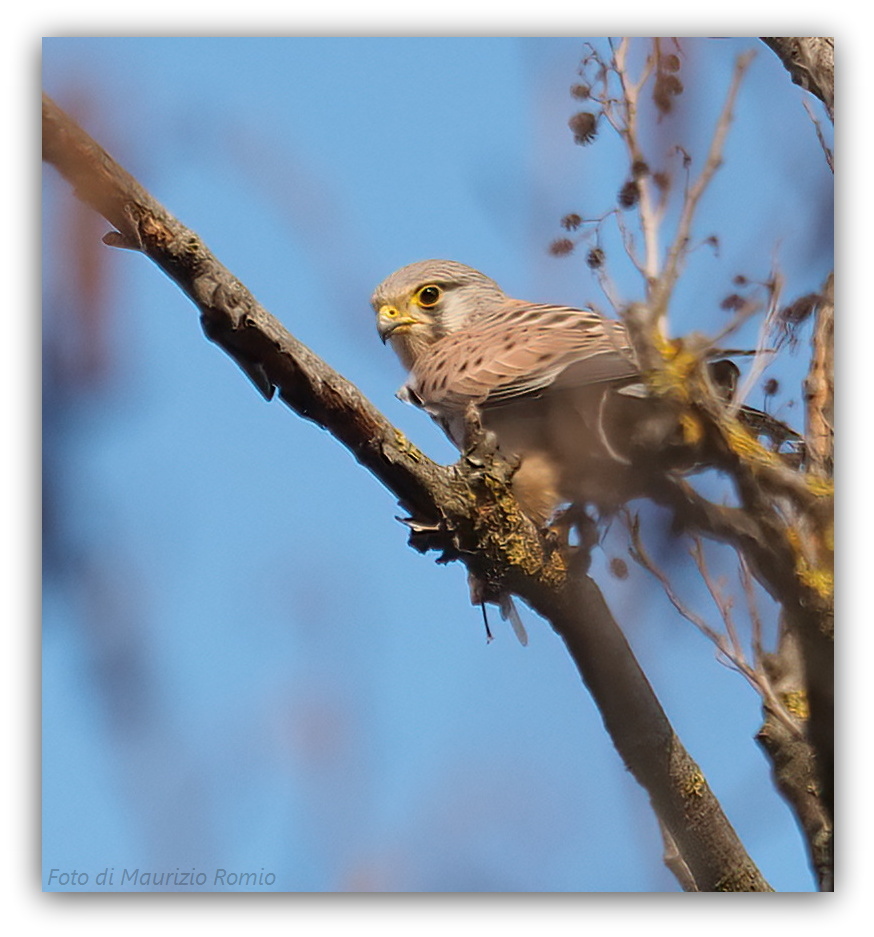
La foto ritrae un esemplare femmina di Gheppio comune (Falco tinnunculus) ed è stata scattata in località “Boschetta” nei pressi della zona Fornaci nel Comune di Costabissara, in provincia di Vicenza, in data 11/03/2023. Per la ripresa ho utilizzato una macchina fotografica Olympus E-M10 Mark III dotata di lente Olympus 40-150 f2.8 PRO. Foto scattata a mano libera.
The photo depicts a female specimen of Common Kestrel (Falco tinnunculus) and was taken in the locality “Boschetta” near the Fornaci area in the municipality of Costabissara, Vicenza province, on 11/03/2023. For the shooting I used an Olympus E-M10 Mark III camera equipped with Olympus 40-150 f2.8 PRO lens. Photo taken freehand.
Picchio rosso maggiore (Dendrocopos major)

Dalla foto si possono estrapolare alcune peculiarità del Picchio Rosso Maggiore: il piumaggio bianco e nero con il sottocoda di color rosso, il robusto becco appuntito, le zampe munite di forti artigli che, come in questo caso, lo aiutano a rimanere ancorato ai tronchi degli alberi. Per riconoscere i maschi dalla femmine dobbiamo cercare nella nuca una macchia rossa della quale solo i maschi sono dotati. Nel nostro caso quindi il Picchio Rosso ritratto nella foto è un maschietto. Nei giovani esemplari la parte superiore della testa è di colore rosso e detta colorazione andrà a scomparire negli adulti.
“Nel bene o nel male”…finché “morte” non ci separi
Nel bene o nel male questo esemplare di Picchio Rosso Maggiore convive nella stessa limitata area umida, la “Boschetta” di zona Fornaci nei pressi del Comune di Costabissara in provincia di Vicenza, con lo Sparviero recensito nel post del 14/02/2023. Il problema risiede nel fatto che il Picchio Rosso rappresenta per lo Sparviere una potenziale preda. Nella stessa piccola area lo Sparviero si mimetizza mentre il Picchio Rosso si evidenzia con i suoi colori sgargianti. Probabilmente di comune accordo condividono questo piccolo lembo di natura che a stento ancora sopravvive circondato dagli elementi antropici umani sempre più invasivi.
The Red-cockaded Woodpecker
From the photo we can extrapolate some peculiarities of the Great Spotted Woodpecker: the black and white plumage with the red undertail, the strong pointed beak, the legs equipped with strong claws that, as in this case, help it to stay anchored to tree trunks. To recognize males from females we must look in the nape of the neck for a red spot with which only males are endowed. In our case therefore the Red-cockaded Woodpecker pictured in the photo is a male. In young specimens the top of the head is red, and said coloration will go away in adults.
“For better or for worse”…until “death” separates us
For better or for worse, this specimen of Great Spotted Woodpecker cohabits in the same limited wetland area, the ” Woodlot” of the Fornaci area near the Municipality of Costabissara in the province of Vicenza, Italy, with the Sparrowhawk reviewed in the post of 14/02/2023. The problem lies in the fact that the Red Woodpecker represents potential prey for the Sparrowhawk. In the same small area the Sparrowhawk camouflages itself while the Red-cockaded Woodpecker stands out with its bright colors. Probably by mutual agreement they share this small patch of nature that still barely survives surrounded by the increasingly invasive human anthropogenic element.
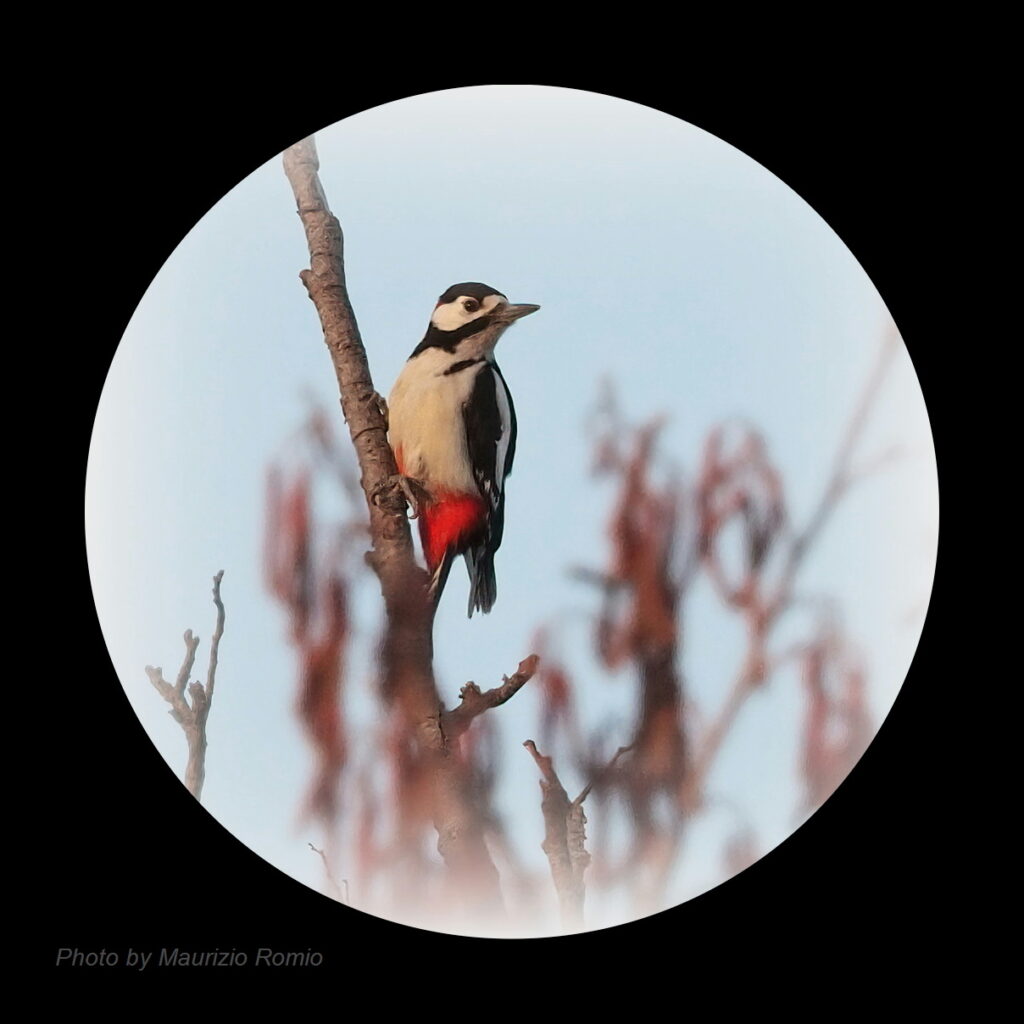
Il mimetismo dello Sparviere

Bella la natura.
In questa foto si può cogliere il mimetismo degli animali.
Lo Sparviere ritratto nella foto si confonde in maniera impeccabile con i colori degli elementi naturali di un bosco. Sicuro del suo mimetismo, che lo fa quasi scomparire e passare inosservato, lo Sparviere osserva, curioso e attento, con i suoi grandi occhi gialli, l’intruso che si è introdotto nel suo spazio. Lo Sparviere (o Sparviero, sono accettate entrambe le denominazioni), nome scientifico Accipiter nisus, è un rapace diurno ed è fra i rapaci più abili nel volo fra i rami fitti di un bosco e questo grazie anche alla sua lunga coda che gli funge da timone e che lo aiuta nelle evoluzioni fra i rami. La lunghezza totale del suo corpo varia dai 28 ai 39 cm e la lunghezza della sua coda rappresenta circa il 40% della lunghezza totale. Anche le sue ali corte e arrotondate gli permettono di destreggiarsi con agilità e destrezza tra i rami fitti di un bosco. La foto che qui ritrae lo Sparviere è stata scattata in località “Boschetta” nei pressi della zona Fornaci nel Comune di Costabissara, in provincia di Vicenza, in data 13/02/2023. Per la ripresa ho utilizzato una macchina fotografica Olympus E-M10 Mark III dotata di una lente Olympus 100-400 F5.00-6.3 IS micro quattro terzi fissata su treppiede dotato di testa gimbal.
The Sparrowhawk camouflage
Beautiful nature.
The camouflage of animals can be captured in this photo.
The Sparrowhawk portrayed in the photo blends impeccably with colors of the natural elements of a forest. Confident in its camouflage, which makes it almost disappear and go unnoticed, the Sparrowhawk watches, curious and attentive, with its large yellow eyes, the intruder that has intruded into its space. The Sparrowhawk, scientific name Accipiter nisus, is a diurnal bird of prey and is among the most adept birds of prey in flight among the dense branches of a forest, and this is due in part to its long tail, which acts as its rudder and helps it in its evolutions among the branches. Its total body length ranges from 28 to 39 cm, and the length of its tail accounts for about 40 percent of its total length. Its short, rounded wings also enable it to maneuver with agility and dexterity among the dense branches of a forest. The photo here of the Sparrowhawk was taken in the locality “Boschetta” near the Fornaci area in the municipality of Costabissara, in the province of Vicenza, Italy, on 02/13/2023.
For the shot I used an Olympus E-M10 Mark III camera equipped with an Olympus 100-400 F5.00-6.3 IS micro four-thirds lens fixed on a tripod equipped with a gimbal head.
Cometa C/2022 E3 (ZTF) (Cometa di Neanderthal)

Ho desiderato documentare con alcuni scatti fotografici il passaggio, sopra il cielo di Costabissara (Italia), della Cometa C/2022 E3 (ZTF) denominata Cometa di Neanderthal.
Dati ripresa.
Data: 10 febbraio 2023 ore 22.06
Località: Italia, Costabissara (VI)
Macchina fotografica: Olympus E-M10 Mark III
Lente: M.Zuiko Digital ED 40-150mm F2.8 PRO
Scatto: Lunghezza focale: 150.0 mm; tempo di esposizione otturatore: 6.1 sec.; diaframma: F2.8; sensibilità ISO 1600; treppiede.
Il precedente avvicinamento alla Terra di questa cometa chiamata C/2022 E3 (ZTF) risale a circa 50 mila anni fa quando sul nostro Pianeta viveva ancora l’uomo di Neanderthal, da qui la derivazione del suo appellativo. Questa cometa ha un diametro di circa mille metri e la sua minima distanza dalla Terra è stata di 42 milioni di chilometri. L’ammasso ghiacciato delle comete, costituito da gas e polveri, può rendersi visibile quando le comete nel corso della loro orbita si avvicinano al Sole.
Comet C/2022 E3 (ZTF) (Neanderthal Comet)
I wished to document with some photographic shots the passage, over the sky of Costabissara (Italy), of Comet C/2022E3 (ZTF) called the Neanderthal Comet.
Shooting data.
Date: 10 February 2023 10:06 p.m.
Location: Italy – Costabissara (VI)
Camera: Olympus E-M10 Mark III
Lens: M.Zuiko Digital ED 40-150mm F2.8 PRO
Shot: Focal length: 150.0 mm; shutter exposure time: 6.1 sec; aperture: F2.8; ISO sensitivity 1600; tripod.
The previous approach to Earth of this comet named C/2022 E3 (ZTF) was about 50 thousand years ago when Neanderthals still lived on our Planet, hence the derivation of its nickname. This comet has a diameter of about 1,000 meters, and its shortest distance from Earth was 42 million kilometers. The cluster icy of comets, consisting of gas and dust, can become visible when comets in the course of their orbit approach the Sun.

Poiana in volo tra i rami
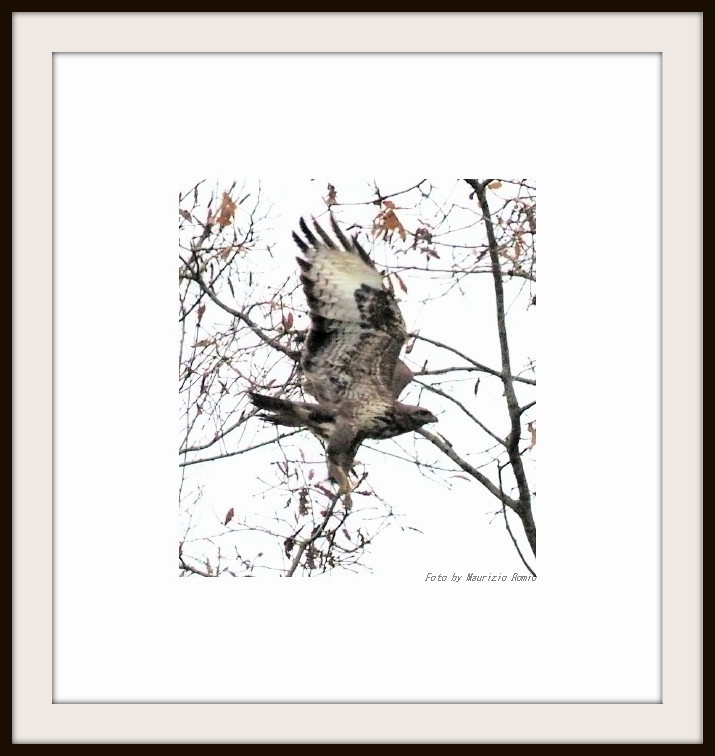
Buzzard in flight among the branches. Location Ca’ Mello – Porto Tolle – Po Delta. Date taken: 30/12/2022. Photo Maurizio Romio
